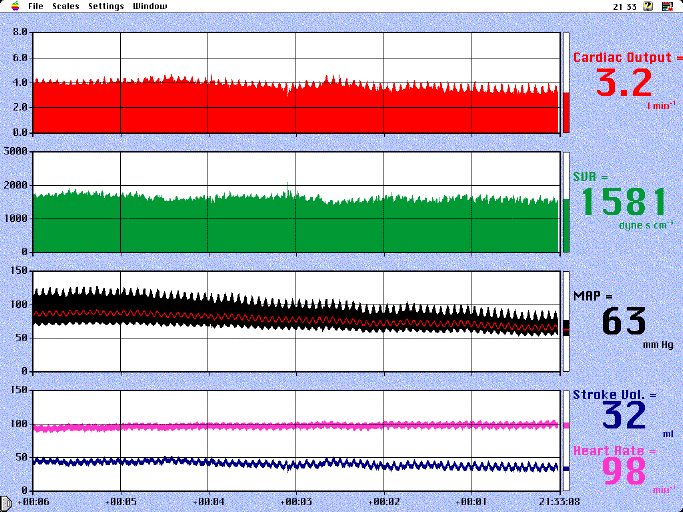

Systolic pressure variation
This shows 'systolic pressure variation' which is the term used to describe the variation in systolic pressure induced by positive pressure ventilation. It occurs whether the chest is open or closed - in this patient the chest was still open after cardiopulmonary bypass.
The cycle frequency is the same as that of the ventilator. As the lungs are inflated blood is squeezed out and so there is a small rise in left atrial and therefore left ventricular end diastolic pressure (LVEDP). The lower the LVEDP the greater the effect of an increase on left ventricular stroke volume and arterial pressure. The increased flow of blood to the left atrium during lung inflation produces a small fluid challenge which is repeated each breath, hence its usefulness in assessing the likely response of the patient to transfusion. In this example the blood pressure is falling and the systolic pressure variation is increasing and so the patient needs transfusing.
The magnitude of the effect will depend on the tidal volume delivered by the ventilator, the left atrial pressure and the state of the left ventricle. In the literature there is some confusion about the mechanism (Beaussier, 1995; Stoneham, 1999), but the subject has been studied extensively and clear descriptions are given for example by Rooke et al, 1995. At the start of the inspiratory phase of intermittent positive pressure ventilation blood is squeezed out of the lungs and produces a transient increase in left atrial pressure and augmentation of left ventricular end-diastolic volume. The increase in stroke volume causes an increase in arterial blood pressure.This can be clearly seen if you watch the arterial pressure trace in relation to airway pressure - see example. The fall in arterial pressure during expiration is due to reduction in left atrial pressure, as pulmonary venous flow is reduced. The mechanism of this reduction is probably 1. replenishment of intrapulmonary blood volume (it was reduced when blood was squeezed out of the lungs during inflation), and 2. the delayed effect of a reduced right ventricular output during inspiration, an effect which would be more marked in a subject with a closed chest when the rise in intrathoracic pressure and consequent reduction in venous return would be greater.
There may be occasions when all is not what it seems - see masquerading SPV.